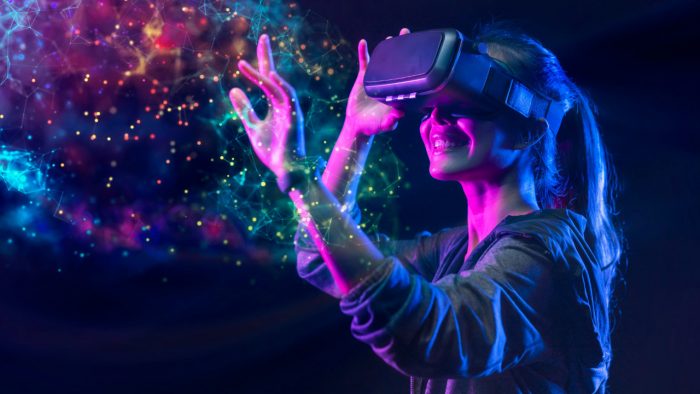Virtual Reality (VR) has evolved beyond being just a technological trend and has become integral to diverse aspects of our lives. It’s not limited to gaming and entertainment; it’s making significant strides in healthcare and education, reshaping industries, and expanding the limits of what we thought achievable. In this article, we’ll delve into the versatile impact of VR, tracing its journey from humble beginnings to the promising future it envisions.
I. Introduction
A. Definition of Virtual Reality (VR)
“To begin, let’s delve into the essence of VR. Virtual Reality involves a computer-generated simulation that engulfs users in a three-dimensional environment. This synthetic reality is typically crafted through VR headsets, delivering an interactive and realistic encounter.”
B. The Evolution of VR technology
The journey of VR dates to its conceptualization in the mid-20th century. However, it wasn’t until recent years that advancements in technology catapulted VR into the mainstream. From clunky prototypes to sleek and powerful VR headsets, the evolution has been nothing short of remarkable.
C. Importance of VR in the tech landscape
VR is not just a technological gimmick; it’s a transformative force. Its ability to merge the digital and physical worlds opens a realm of possibilities, making it a pivotal player in the ever-evolving tech landscape.
II. The Rise of VR in Different Industries
A. Gaming and Entertainment
1. Immersive gaming experiences
One of the primary drivers of VR’s popularity is its impact on gaming. Gamers can now step into virtual worlds, blurring the lines between reality and fantasy. The immersive nature of VR enhances the gaming experience, offering unparalleled levels of engagement.
2. Virtual concerts and events
Beyond gaming, VR has found its place in the entertainment industry. Virtual concerts and events allow people to participate from the comfort of their homes, breaking geographical barriers and fostering a global community of participants.
B. Healthcare
1. VR in medical training
In the healthcare sector, VR is revolutionizing medical training. Medical professionals can simulate surgeries and procedures in a risk-free environment, refining their skills before stepping into the operating room.
2. Therapeutic applications of VR
VR is also proving to be a powerful tool in therapy. Patients can confront fears and phobias in a controlled virtual setting, opening new avenues for mental health treatment.
C. Education
1. Virtual classrooms
Education is another domain where VR is making waves. Virtual classrooms transport students to historical events, faraway places, and even inside the human body, creating immersive and unforgettable learning experiences.
2. Enhanced learning experiences
By incorporating VR into education, teachers can cater to various learning styles, making lessons more engaging and accessible. Complex concepts become tangible, fostering a deeper understanding among students.
III. VR Hardware Advancements
A. Evolution of VR headsets
The hardware powering VR experiences has seen significant advancements. From the early days of heavy headsets to the sleek and lightweight devices available today, VR hardware continues to evolve, enhancing comfort and performance.
B. Importance of high-quality VR hardware
The quality of VR hardware directly impacts the overall experience. High-resolution displays, responsive sensors, and ergonomic designs contribute to an immersive and enjoyable journey into virtual realms.
C. Accessibility and affordability of VR devices
As technology progresses, VR devices are becoming more accessible and affordable. This increased affordability is democratizing access to VR, allowing a broader audience to experience its wonders.
IV. Challenges and Concerns in VR
A. Motion sickness and discomfort
Despite its many advantages, VR is not without challenges. Motion sickness and discomfort are common issues, especially for those new to the technology. Developers are actively working on minimizing these issues to ensure a seamless experience for users.
B. Ethical concerns in VR content creation
The creation of VR content raises ethical questions. As virtual worlds become more realistic, concerns about the impact of violent or inappropriate content on users’ mental well-being come to the forefront.
C. The digital divide and VR accessibility
While VR is becoming more accessible, a digital divide still exists. Not everyone has equal access to technology, creating disparities in opportunities for education, entertainment, and healthcare.
V. The Future of VR
A. Emerging trends in VR technology
The journey of VR is far from over. Emerging trends, such as haptic feedback, improved AI integration, and augmented reality (AR) synergies, promise to elevate the VR experience to new heights.
B. Potential breakthroughs in VR applications
Researchers are exploring new applications for VR, from virtual tourism to collaborative workspaces. Potential breakthroughs could reshape industries and offer solutions to challenges we haven’t yet imagined.
C. Impact on everyday life and society
Looking ahead, VR is poised to become an integral part of our daily lives. Its impact on society, from changing how we learn and work to transforming entertainment and healthcare, cannot be overstated.
VI. Conclusion
A. Recap of the VR journey
In conclusion, the VR revolution is a testament to human innovation and our desire to push boundaries. From its inception to the present and into the future, VR has evolved into a powerful force, enriching lives and transforming industries.
B. Call to embrace the VR revolution.
As we stand on the cusp of a new era, it’s essential to embrace the VR revolution. Whether you’re a gamer, a medical professional, an educator, or someone simply curious about the possibilities, the immersive world of VR awaits. Strap in, and let the virtual journey begin!




Thanks for your comments!